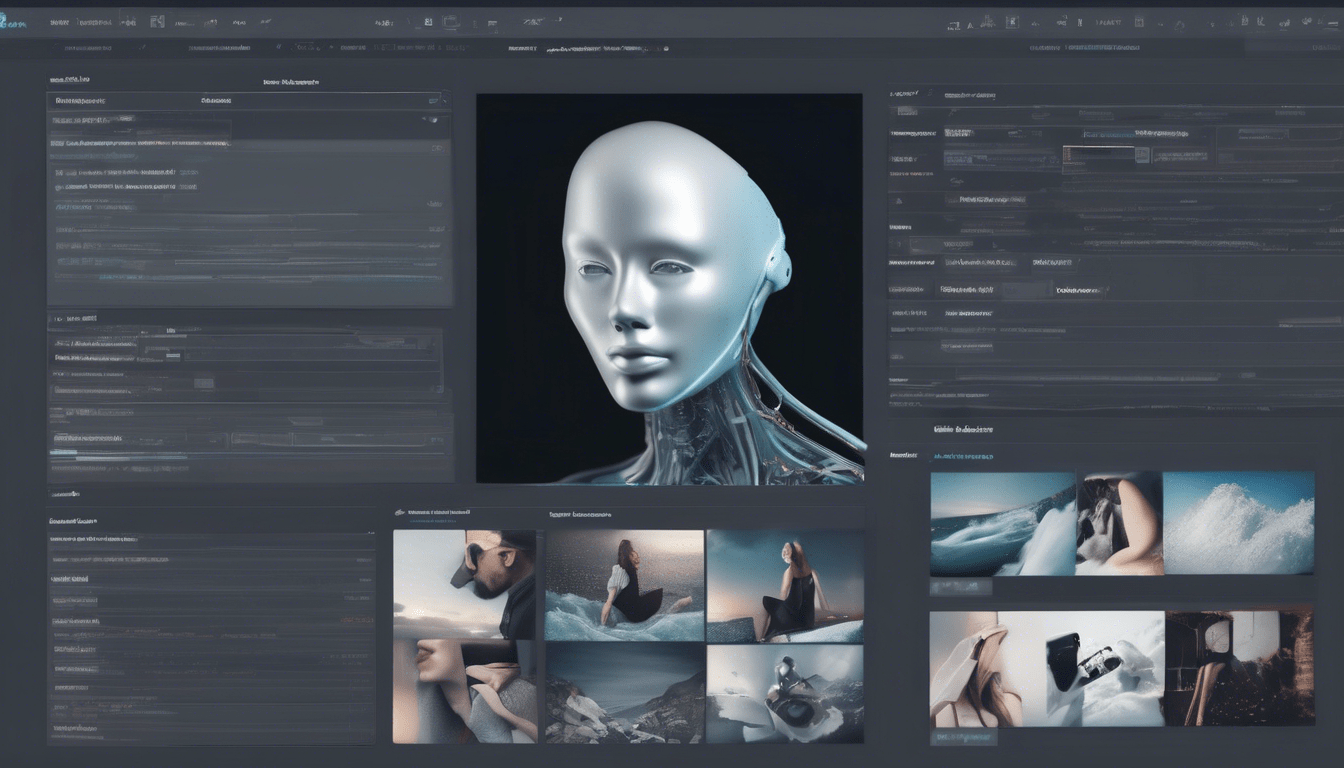Creating subtitles with AI transforms video content by making it more accessible and engaging. AI subtitle generators streamline the process, saving time while expanding reach to diverse audiences. This evolution enhances viewer experience and boosts content discoverability. Exploring the top tools and their capabilities reveals how AI-powered captioning offers practical solutions for creators seeking efficiency and inclusivity in their videos.
Overview of AI Subtitle Generators for Video Transformation
AI subtitle tools have revolutionized how we approach video editing, making video accessibility solutions more sophisticated and user-friendly. At their core, these AI subtitle generators use advanced machine learning algorithms to automatically transcribe speech and sync subtitles with video content, eliminating the need for manual captioning.
Also read : Unlock seamless video creation with an ai subtitles generator
One of the primary benefits of AI subtitle tools is their remarkable efficiency. They can process and generate accurate subtitles in a fraction of the time traditional methods require. This speed not only saves valuable editing time but also allows creators to publish videos faster without sacrificing quality. Additionally, by providing reliable transcriptions, AI subtitle generators improve video accessibility solutions by making content more inclusive for people with hearing impairment and for those who prefer watching videos with text.
Moreover, AI subtitle tools significantly enhance viewer engagement. When subtitles are accurate and well-timed, they help retain audience attention and improve comprehension, especially in noisy environments or when the audio is unclear. Furthermore, subtitles broaden content reach by allowing videos to appeal to non-native speakers and international viewers.
Topic to read : What impact does SEO have on the online visibility of UK businesses?
In sum, AI subtitle generators play a crucial role in modern video editing workflows by blending efficiency, inclusivity, and engagement. Content creators can leverage these tools to ensure their videos are accessible, engaging, and ready for diverse audiences. For those interested in diving deeper into the technology and options available, it’s worthwhile to explore AI subtitle tools and unlock seamless video creation benefits.
Top AI Subtitle Generators for Video Transformation
When searching for the best AI subtitle software, several options stand out due to their advanced capabilities and user-friendly interfaces. These AI video editing tools not only automate transcription but also enhance video accessibility and engagement through accurate subtitle generation.
Otter.ai is renowned for its high-precision transcription accuracy. It leverages sophisticated AI to produce subtitles that closely match spoken content, reducing the need for manual corrections. Otter.ai integrates seamlessly with various video platforms, making it a preferred choice for professionals seeking efficient subtitle creation.
Rev.com combines human transcription services with AI technologies to offer an excellent balance of accuracy and speed. Its AI-powered subtitle tools improve turnaround times while maintaining quality, making it a versatile solution for creators who require reliable captions quickly.
Kapwing’s platform features accessible AI video editing tools designed for content creators with diverse skill levels. Kapwing’s subtitle generator automatically detects speech and syncs subtitles flawlessly, enhancing the viewer’s experience. These capabilities contribute to Kapwing’s growing popularity in the video editing community.
VEED.IO stands out by offering an all-in-one video editing suite that includes a sophisticated AI subtitle generator. Its best AI subtitle software features ensure precise timing and customizable subtitle styles, allowing creators to tailor captions to their brand’s identity.
Descript is a comprehensive AI video editing tool that excels in subtitle creation through its interactive transcript interface. Users can edit captions directly within the transcript, streamlining the subtitle correction process. Descript’s innovative approach facilitates efficient workflows for video producers.
Subtitle Edit Pro is another powerful AI subtitle tool catering to professionals who demand accuracy and flexibility. It supports multiple languages and integrates AI algorithms to optimize subtitle synchronization, enhancing overall video accessibility.
These AI video editing tools collectively advance subtitle generation by emphasizing accuracy, speed, and customization, ensuring creators can elevate their video content with ease. For those interested in learning more about various AI subtitle tools, explore AI subtitle tools to unlock seamless video creation possibilities.
Features and Capabilities of Leading AI Subtitle Generators
Unlocking efficient and precise video captioning
AI subtitle generators have evolved significantly, offering impressive AI subtitle features that enhance video accessibility and engagement. One of the core strengths lies in their automatic speech recognition accuracy. The best tools deliver highly precise transcriptions by leveraging advanced neural network models that minimize errors in capturing spoken words. This precision is crucial for creating reliable subtitles, particularly for videos with diverse accents, rapid speech, or background noise.
Beyond accuracy, customization options play an essential role in tailoring subtitles to fit different video styles and audience needs. Leading AI subtitle generators allow users to modify fonts, colors, sizes, and even placement, ensuring subtitles complement the video aesthetics and improve readability. Timing adjustments are another feature that enables synchronization refinement, helping subtitles perfectly align with speakers’ words, which is especially beneficial for content creators aiming for professional-grade videos.
Integration capabilities further enhance the utility of AI subtitle features. Many top platforms seamlessly connect with popular video editing technology, allowing users to import and export subtitles directly into editing software such as Adobe Premiere Pro, Final Cut Pro, or DaVinci Resolve. This smooth workflow support eliminates manual subtitle import/export hassles and streamlines the entire video captioning process. Users can export subtitles in various formats like SRT, VTT, or embedded options, catering to different platforms and distribution channels.
In essence, leading AI subtitle generators combine cutting-edge speech recognition, rich customization alternatives, and robust integration with video editing technology to provide a comprehensive solution for automatic, high-quality video captioning. To explore how these capabilities can transform your video projects, explore AI subtitle tools.
How to Choose the Right AI Subtitle Generator for Your Needs
Selecting AI subtitle software involves careful evaluation of several key factors to ensure it meets your specific video accessibility needs. First and foremost, accuracy is critical. A high-precision tool minimizes errors in transcription, which is essential for creating reliable subtitles. Accuracy directly impacts the viewer’s comprehension and overall engagement with your video content.
Next, consider the user interface and editing flexibility. A well-designed interface allows you to effortlessly manage subtitles, make corrections, and customize timing. Editing features should be intuitive but robust enough to handle complex adjustments without frustration. For instance, some tools offer timeline-based editing that lets you fine-tune subtitle placement relative to speech.
Cost is another important aspect. Some AI subtitle generators offer scalable pricing models based on usage or features. Assessing the balance between cost and features is important, especially for users with varied requirements such as individuals, educators, or professional video producers. Free or lower-cost options may suffice for simple projects, while advanced functionality might be necessary for commercial applications.
Compatibility with different video formats and platforms should also influence your choice. Ensure the software supports the formats you use and integrates smoothly with your video editing or publishing environment. This ensures a seamless workflow from generating subtitles to distributing your content.
In summary, prioritizing accuracy, user-friendly editing, cost-effectiveness, and compatibility will guide you to the right AI subtitle generator tailored to your needs. To deepen your understanding and see options firsthand, you can explore AI subtitle tools that excel in these areas.
Using AI Subtitle Generators: Step-by-Step Guides
Enhance your videos with precise and efficient AI subtitle creation
Preparing Your Video for Subtitle Generation
Before diving into AI subtitle creation, ensure your video file is clear and of high quality. This clarity aids the accuracy of the AI in recognizing speech for effective video captioning. Choose a video format widely compatible with AI subtitle generators, such as MP4 or MOV, to avoid compatibility issues during the generation process. If your video contains background noise, consider cleaning audio beforehand to improve subtitle accuracy. Properly preparing your video minimizes errors and streamlines the subsequent steps in the video captioning tutorial.
Generating and Editing Subtitles
Once your video is prepped, upload it to your chosen AI subtitle tool. The AI uses speech recognition algorithms to transcribe and automatically generate subtitles. This automatic process significantly reduces the time compared to manual captioning, especially for lengthy videos. After generation, review the subtitles carefully. Even the best AI subtitle creation tools may misinterpret accents, jargon, or homophones, so manual editing ensures the text precisely matches the spoken content. Most platforms offer intuitive editing interfaces, allowing you to adjust the timing and wording to achieve perfect synchronization.
Exporting and Integrating Subtitles in Videos
After editing, it’s crucial to export your subtitles in a format compatible with your video platform or player, such as SRT or VTT files. Integration can be done by embedding subtitles directly into the video file or uploading them as separate caption files alongside the video, depending on your distribution needs. This seamless integration completes the video captioning tutorial by making your content accessible to wider audiences, including those with hearing impairments or in sound-sensitive environments. For those ready to explore additional functionalities and get started immediately, you can always explore AI subtitle tools to unlock effortless and effective subtitle generation.
Benefits of AI-Generated Subtitles for Accessibility and Content Engagement
Providing video accessibility through AI-generated subtitles significantly enhances the experience for hearing-impaired viewers. These subtitles ensure that content is inclusive, allowing those with hearing difficulties to fully engage without missing critical information. This not only meets legal accessibility standards but also fosters a welcoming environment for a diverse audience.
Moreover, AI-generated subtitles boost audience engagement by improving viewer comprehension. Many users watch videos with the sound off—whether in public places or during multitasking—and subtitles enable them to follow the content without audio. This feature raises viewer retention rates, as clear text supports sustained attention and better understanding.
From a discoverability perspective, subtitles assist video SEO, making the content more searchable and discoverable on platforms. Search engines can index subtitle text, providing additional keywords that enhance a video’s online presence.
Overall, incorporating AI-generated subtitles is a practical, effective way to maximize both accessibility and engagement, benefiting creators and viewers alike. To learn more about AI subtitle tools, you can explore AI subtitle tools to unlock seamless video creation.
Challenges and Limitations of AI Subtitle Generation
AI subtitle generation, while innovative, faces several AI subtitle limitations that impact caption accuracy. One of the main challenges is transcription accuracy, especially in noisy environments. Background sounds, overlapping conversations, and poor audio quality frequently lead to errors, causing the AI to misinterpret or omit words. This results in lower caption accuracy and can detract from the viewer’s experience.
Handling multiple speakers further complicates AI captioning. Differentiating voices and attributing statements correctly remains a struggle due to the AI’s limited contextual understanding. This problem becomes even more pronounced with complex vocabulary or industry-specific jargon, where AI may fail to recognize or properly transcribe certain terms, leading to caption accuracy issues.
Despite these challenges, ongoing developments in AI captioning technology aim to improve performance. Researchers are working on enhanced noise filtering, speaker diarization, and language models that better understand context and specialized vocabulary. As AI models evolve, these AI subtitle limitations will diminish, making subtitles more reliable for diverse video content. For those interested in practical applications, you can explore AI subtitle tools that showcase the latest advancements in this space.
Future Trends in AI Subtitle Technology
Advancements shaping tomorrow’s video experience
The landscape of AI captioning innovations is evolving rapidly, with significant strides in natural language processing (NLP) powering more accurate and context-aware subtitles. Future AI subtitle technology is expected to integrate increasingly sophisticated NLP models, enabling better understanding of nuanced speech patterns, accents, and even emotion in dialogue. This will dramatically enhance the precision of captions, making them not only more reliable but also more reflective of the original content’s intent.
Real-time captioning advancements are another major trajectory, especially relevant for live streaming. Enhanced algorithms will minimize latency and amplify subtitle accuracy during fast-paced or dynamic events, ensuring viewers receive immediate, clear text alongside live video. This progress addresses one of the biggest challenges in video accessibility trends, where delay or error in live captions can reduce viewer engagement and comprehension.
Moreover, the broader adoption of AI subtitles across various industries beyond entertainment and media will cement its importance. Sectors such as education, corporate training, and healthcare will increasingly rely on AI-generated captions to make video content accessible to diverse audiences. This widespread integration supports not only legal accessibility compliance but also enriches user experience for non-native speakers and those with hearing impairments.
These developments emphasize that AI subtitle technology is no longer a niche tool but a fundamental part of inclusive communication. Businesses and creators interested in unlocking seamless video creation with an AI subtitles generator should closely monitor these emerging innovations to remain competitive and accessible. To delve deeper into how AI can transform your video projects, explore AI subtitle tools.
Final Tips for Optimizing AI Subtitle Usage
Enhance your video content with precision and accessibility
To maximize the impact of AI subtitle optimization, manual editing remains an essential step after automatic generation. While AI tools offer impressive accuracy, reviewing subtitles ensures correction of context-specific errors, proper punctuation, and capturing nuances the AI may miss. Pay attention to homophones, speaker names, and specialized terminology during editing to attain optimal clarity.
Ensuring subtitle synchronization is vital for viewer comprehension and engagement. Use video timelines and synchronization features to align subtitles precisely with spoken words. Delays or early appearances can distract viewers and reduce the effectiveness of your video accessibility strategies. Many tools allow frame-by-frame adjustments to perfect timing, which is especially important for fast-paced dialogue or multiple speakers.
Beyond aiding comprehension, well-implemented subtitles enhance your video’s reach by improving SEO and accessibility. Search engines index subtitle text, increasing discoverability and ranking potential. To leverage this fully, include relevant keywords naturally within subtitles. Moreover, subtitles open your content to audiences who are deaf or hard of hearing and to non-native speakers, broadening your viewer base dramatically.
By integrating thorough manual corrections, rigorous synchronization practices, and strategic subtitle use, you can harness the full benefits of AI subtitle optimization and robust video accessibility strategies. To deepen your understanding and try practical tools, explore AI subtitle tools that simplify video creation while boosting accessibility and SEO performance.







